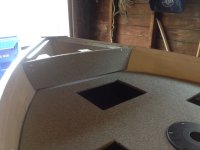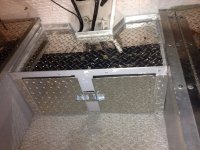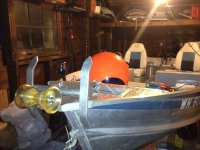bdub065
Member
As with every post I read I must thank everyone for all of their insight and knowledge on the topic. My build would have been far more difficult and minus a few cool stolen ideas without you Tinboat members!
So my story begins with an unfortunate beginning as the boat was my uncles before me. Last summer he had a large stroke and will no longer be able to fish so the boat had to go. I received a call from my dad as they reached out to us knowing all the men in our side of the family were fishermen to see if any of us needed a boat. Since you can never have too many boats I jumped on the opportunity to buy my first. I am 26 years old and have been very privileged with boating options (dad: 18' Smokercraft sled, 18' 55 Thompson wood runabout, Brother: 16' Alumacraft drift boat) which let me fish anywhere I have needed in Oregon. But the opportunity for a first boat of my own was just far to good! I am still hoping that at some point he will be able to go on a trip with me in the final product, but at this point it doesn't look like this will be a possibility, he is stable but will be unable to be in a boat.
I ended up driving up to WA for the weekend to spend some time with my uncle and cousins and by the end of it I was the owner of two boats! One I gave to my dad as a little 12' riveted aluminum w/o trailer and the other was my new 15' bluefin profish.
Included was the 35hp Force engine, 50 lb thrust Minn Kota bow mount, 2X batteries, trailer, 2X cannon down-riggers 4 seats, some lake anchors, dock bumpers and some misc fishing gear. This all came with the 12' boat for 500$. I owe him a ton for the deal that he gave me and couldn't be happier with the canvas to start my Salmon/Trout/Steelhead rig.
Attached are a few of the beginning photos.
So my story begins with an unfortunate beginning as the boat was my uncles before me. Last summer he had a large stroke and will no longer be able to fish so the boat had to go. I received a call from my dad as they reached out to us knowing all the men in our side of the family were fishermen to see if any of us needed a boat. Since you can never have too many boats I jumped on the opportunity to buy my first. I am 26 years old and have been very privileged with boating options (dad: 18' Smokercraft sled, 18' 55 Thompson wood runabout, Brother: 16' Alumacraft drift boat) which let me fish anywhere I have needed in Oregon. But the opportunity for a first boat of my own was just far to good! I am still hoping that at some point he will be able to go on a trip with me in the final product, but at this point it doesn't look like this will be a possibility, he is stable but will be unable to be in a boat.
I ended up driving up to WA for the weekend to spend some time with my uncle and cousins and by the end of it I was the owner of two boats! One I gave to my dad as a little 12' riveted aluminum w/o trailer and the other was my new 15' bluefin profish.
Included was the 35hp Force engine, 50 lb thrust Minn Kota bow mount, 2X batteries, trailer, 2X cannon down-riggers 4 seats, some lake anchors, dock bumpers and some misc fishing gear. This all came with the 12' boat for 500$. I owe him a ton for the deal that he gave me and couldn't be happier with the canvas to start my Salmon/Trout/Steelhead rig.
Attached are a few of the beginning photos.



















































































